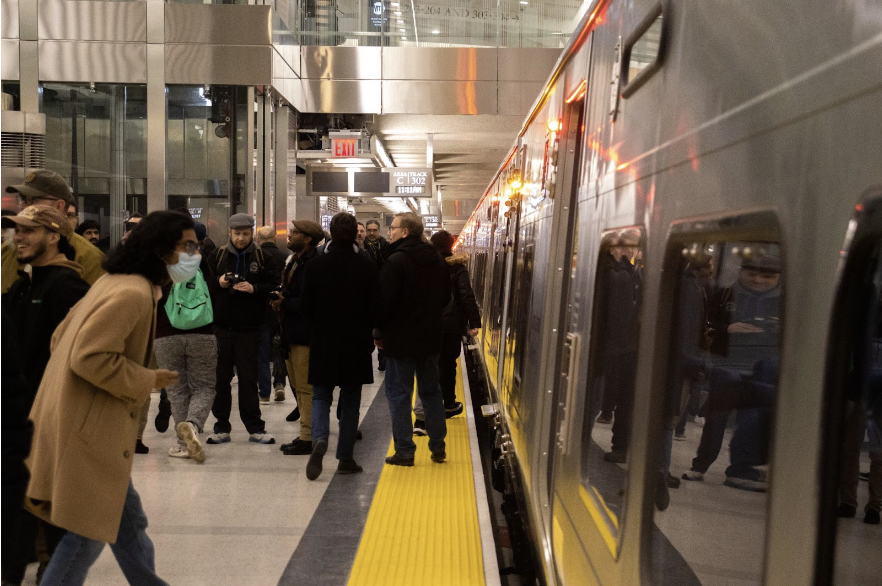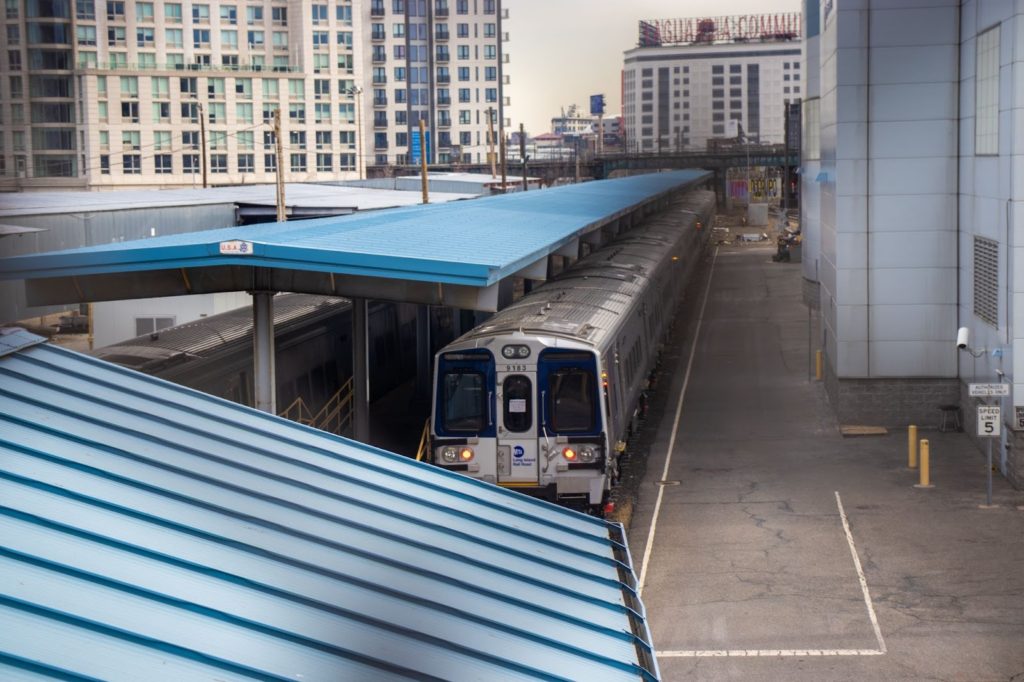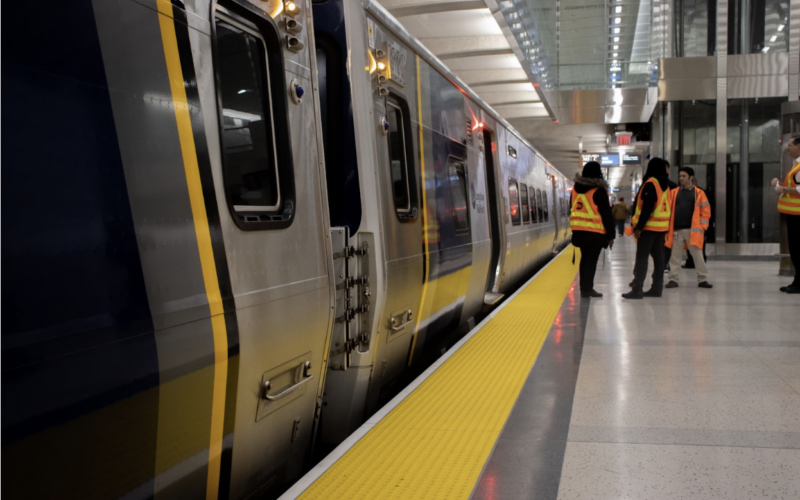Grand Central Madison: 50 years in the making, 50 years wasted?
Media provided by Ryn Harwood ’25.
January 25, 2023: Jamaica station.
The air is electric. As the 09:56 Ronkonkoma, 09:50 Long Beach, 10:05 Port Jefferson, and 10:19 Babylon trains enter the major Queens rail hub, railfans and news anchors flood the concourse hovering above the 10 platforms. Every 7 minutes, as an AirTrain pulls into the terminal south of the Long Island Railroad tracks, tourists get lost in the sea of excitement. Finally, at 10:30, the passenger information announcement plays:
“The train to Grand Central is now boarding on track 3, stopping at Grand Central only.”
Suddenly, as if by magic, the entire concourse empties as the passengers spill onto the platform and into the train.
Grand Central Station is a historic transportation hub that has been serving commuters and travelers for more than a century. The station was first opened in 1913 as Grand Central Terminal, replacing the previous Grand Central Depot that had been in operation since 1871.
Designed in the Beaux-Arts style, the building features a grand concourse with a stunning celestial ceiling and distinctive clock tower situated in the center. Grand Central Terminal endured a major restoration project in the 1990s that helped to preserve and enhance its historic beauty, which is severely juxtaposed with the destruction of the original structure at Penn Station for a newer, more cramped underground complex.

Grand Central Madison has been planned ever since the inception of the 63rd Street F train connection in 1967. When planning this project, the MTA included a lower track below the subway line across Roosevelt Island for future mainline rail running across from Queens into Manhattan. These lower-level tunnels carry trains off of the existing mainline in Queens through to Grand Central Station.
The new LIRR concourse is found deep below the existing building. A ride down the longest escalator in the city, measuring 182 ft. in length and 90 ft. in depth, takes passengers from the familiar Grand Central Terminal to the mysterious and pristine Grand Central Madison.
Governor Kathy Hochul was aboard the first train, alongside MTA CEO Janno Lieber, as it took off (on time!) bound for its arrival at Grand Central Madison at 11:07.
In her public address, Governor Hochul stated that “Grand Central Madison is a game changer for New Yorkers, and I look forward to welcoming Long Island commuters to our tremendous new terminal. …Infrastructure is all about connections, and this project is an extraordinary step forward to better connect millions of New Yorkers with their homes, their families and their jobs.”
In some good news for Long Islanders who commute to Grace, the MTA had estimated that at least “45% of Long Island Rail Road commuters are expected to go to Grand Central Madison, so there will be less crowding at Penn Station and the surrounding subway lines.”
These pieces of evidence, in conjunction with the completion of the second track between Farmingdale and Ronkonkoma and the third track between Floral Park and Hicksville, are estimated to increase the total capacity of the LIRR by up to one and a half times its current abilities.
Unfortunately, the new M9 LIRR car delivery schedule has been delayed repeatedly, with only 74 total cars in revenue service as of May 2021. The remaining 128 cars are not yet in the MTA’s hands, despite being expected to be in revenue service by April 2021. With the gap between new total capacity and in-service cars still present, the MTA has re-introduced their 1980s-era M3 cars back into revenue service until the M9s can fill the gap.
Many railfans have spotted several M3 sets in Jamaica yard as their revenue trains shuttle in and out of the station prior to the opening of Grand Central Madison. Since the implementation of the new timetables, M3s have been regularly seen providing extra capacity on a multitude of journeys..
For the first three weeks, trains were shuttled between Grand Central and Jamaica, using only tracks 301 and 302. However, the MTA introduced full service on Monday, Feb. 27, with the new terminal having the potential capacity to run up to 24 trains per hour.
During the peak times in the initial three weeks, trains ran hourly, with a midway stop at Woodside to provide service for Port Washington passengers. During off-peak hours, trains ran every half hour, with one train running express with no stops between the two hubs and one train making stops at Kew Gardens, Forest Hills, and Woodside before arriving at Grand Central.

Unfortunately, a signal failure at Jamaica caused delays in both directions on day one of the new schedule, but otherwise, there were no reported issues with the new timetables. The MTA has introduced a key timetable feature in which many peak trains will make only one stop between Manhattan and Jamaica, either at Kew Gardens, Forest Hills, or Woodside. The MTA hopes that this will distribute congestion among trains in the corridor, instead of packing all Queens local passengers into one train.
Throughout the week, LIRR passengers continued to complain about new schedules and train length. LIRR interim president Catherine Rinaldi has told multiple sources that “we are looking on a train-by-basis every train every day how long is it, who’s on it how crowded is it and we’re making adjustments to be able to reflect actually what we’re seeing out there,” indicating that the timetables will adjust to passenger demand as time progresses. The MTA is promising that with time, timetables will fit the needs of riders.
Alex Dillon, a History teacher here at Grace, lives on Long Island and rides in from Ceaderhurst on the Far Rockaway branch, and most Far Rockaway trains will be sent to Grand Central. He was initially interviewed before the newest timetables were brought into effect.
“Occasionally, I have to change at Jamaica which takes up my time, but I often take direct trains to Penn when I can.”
Mr Dillon told the Gazette that there are “going to be more possibilities” due to the enhanced capabilities and capacities.
“I sometimes take the subway to Atlantic Terminal in Brooklyn and go from there … there will be three possibilities instead of two.”
He told the Gazette that he rides a CitiBike from Penn to Grace on days with clear skies and “tries to avoid the subway when possible. It will definitely be easier biking downtown from Grand Central than biking across town from Penn Station.”
The opening of Grand Central Madison provides a 2-seat ride from Jamaica to Grace, only requiring a transfer to the 6 train at 42 St-Grand Central. The MTA estimates that many journeys will have their travel time cut down 25 minutes. The terminal also allows commuters to avoid the crowded Penn Station for the spatial alternative on the East Side.
Mr Dillon was then interviewed in April to recap his thoughts after weeks of commuting with the terminal and new timetables into play and brought up many valid counterarguments to implementing the timetables.
“The station is very deep underground; walking in and out of that station is very time-consuming because it’s such a long escalator ride,” highlighting the fact that the depth of the station nullifies many of the benefits of having an East Side LIRR terminal.
“I’ve continued going to Penn, as there are a larger number of trains, in general, going into the city in general, and it’s easier to bike to Grace from Penn as opposed to Grand Central. What’s disappointing is that it’s bad for Brooklyners who aren’t getting direct trains anymore and that transfers at Jamaica are no longer coordinated. They used to be carefully timed, but now you have to stand around in Jamaica for ten to fifteen minutes. Jamaica is crowded, cramped, unable to handle the capacity.”
Grand Central Madison was originally envisioned as revolutionary not only for Long Island-based Grace community members but for Long Islanders. But now, after seeing both the benefits and the downsides of the new terminal, we can only hope that the MTA will continue to adjust timetables to rectify many of the concerns that Long Islanders have.
Ryn Harwood ‘25, the author and a staff writer at The Gazette, is a true railfan.

